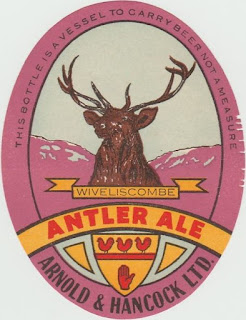It's about half way into the article that I started getting puzzled. When the author visits the brewery cellars.
That the brewery housed so many large vats came as quite a surprise. Not what I would have guessed at all.
"After taking a peep into a vat of gigantic dimensions, where lies a quantity of liquor undergoing fermentation, we again proceed below, and, passing once more the busy yard where stalwart men are busy, steaming and washing empty casks and marking and loading fall ones, next we come to the vaults where the beer is stored away in a perfect army of vast casks waiting to be transmitted east, west, north, and south as orders come in, the storage capabilities of the place being 10,000 barrels. Here, in various cellars, are casks truly Brobdignagian dimensions, holding beer of any age from one day to nine years old, and one. I believe, was said to be very much older. All these have their distinctive apellations; for instance, here, in one room, termed the “Coffee Pot" cellar, is the “Coffee Pot,” holding 390 barrels; the “Canister,” 330 barrels; the “Punchbowl,” 319, and five “Coffee Cups,” having each capacity 25 barrels. Near by is the “Old Hundredth.” which hums to the generous tune of 150 barrels; and in another cellar are “Peace" and “Plenty,” holding 404 and 670 barrels respectively. These were put up after the Crimean War in 1854. In a cellar formerly known as the “Volunteer" cellar are the “Captain.” 1,101; the “Lieutenant," 712; the “Ensign.” 250 barrels; and the “Little Drummer,” parched perkily alongside his superior officers, with 40 barrels inside his waist. Farther on are more of these gigantic casks, the “Bucket” taking the lead of the whole with a capacity of 1,128 barrels, or (reckoning 36 gallons to the barrel) 40,608 gallons, after which the “Pitcher," 638; the “Tub," 700; the “Banbury,” 533; the “Teapot,” 531; the “Tankard,” 525; and the “Barley-corn,” 300 barrels, take but modest back seat. Each these enormous casks stands upright its head on supports, and when it is said that each barrel of beer counts up 4cwt., it may be realised that strong supports are necessary to hold up the “Bucket,” the “Tub, or the “Captain.” All the cooperage, from the modest “pin” to the mighty “bucket,” is done the premises, and it is on record that the men who built the “Captain,” afterwards, together with their friends, to the number of 30 in all, dined inside it, and after the tables were cleared away some of the party indulged in the novelty of a dance at the bottom a beer cask. As the diameter of the bottom is about 20 feet, it may be seen that such proceeding was quite within the range of possibility. All these huge vessels are full of beer of varying age, and underneath are still other vaults holding armies of casks waiting, like prisoners, for transportation."
West Somerset Free Press - Saturday 24 May 1890, page 7.
10, 000 barrels is almost 5 months' worth of Hancock's output. Which seems an awful lot. Though it is stated that some of the beer was nine years old. Given the amount of beer they brewed, it would have taken several years to fill all those vats.
The largest batch I've seen in the brewing records was around 100 barrels. Meaning that the largest vat, holding over 1,000 barrels, would have taken at least 11 brews to fill. Or a couple of weeks, even if they brewed nothing else. It doesn't seem very practical.
The big mystery is which beer they were ageing in vats. I'll remind you of the beers Hancock brewed:
| Hancock output second half of 1888 |
| Beer |
Style |
OG |
Barrels |
% |
| BA |
Pale Ale |
1060.1 |
313 |
2.53% |
| BB |
Pale Ale |
1052.6 |
559 |
4.52% |
| GA |
Pale Ale |
1039.3 |
1,406 |
11.38% |
| Porter |
Porter |
1052.6 |
77 |
0.62% |
| Stout |
Stout |
1066.3 |
689 |
5.58% |
| XX |
Mild Ale |
1050.2 |
9,313 |
75.37% |
| Total |
|
|
12,357 |
|
| Source: |
| Hancock brewing record held at South West Heritage Trust
Somerset Archive, document number DD/HCK/5/2/1. |
I can only see two candidates for vat ageing: BA and Stout. But in six months only 1,002 barrels were brewed of the two combined.















